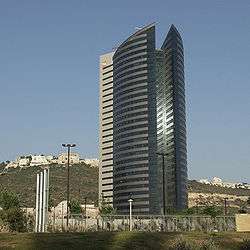Israel Electric Corporation
 | |
|
IEC Tower, company's headquarters | |
| Government-owned corporation | |
| Industry | Electric utilities |
| Founded | 1923 |
| Founder | Pinchas Rutenberg |
| Headquarters | Haifa, Israel |
Area served | Israel |
Key people |
Yiftach Ron Tal (Acting Chairman since 2011) Ofer Bloch (CEO) |
| Products | Electricity generation, transmission and distribution |
| Revenue | ₪ 27.7 billion (2013)[1] |
| ₪ 1.4 billion (2013)[1] | |
| ₪ (808) million (2013)[1] | |
Number of employees |
9,782 permanent employees 2,894 temporary employees |
| Website | iec.co.il |

Israel Electric Corporation (Hebrew: חברת החשמל לישראל, abbreviation: IEC) is the main supplier of electrical power in Israel. IEC builds, maintains, and operates power generation stations, sub-stations, as well as the transmission and distribution networks.
The company is the sole integrated electric utility in the State of Israel. and generates, transmits, and distributes substantially all the electricity used in Israel. The State of Israel owns approximately 99.85% of the company.[2]
History
The Jaffa Electric Company was founded in 1923 by Pinhas Rutenberg, and was later absorbed into a newly created Palestine Electric Company.[3]
The company was incorporated in Mandatory Palestine with its main object to produce, supply, distribute, and sell electricity to consumers. Israel Electric Corp. was first registered under the name "The Palestine Electricity, Corporation Limited", which was changed in 1961 to its present name "The Israel Electric Corporation Limited".
Today
The IEC is one of the largest industrial companies in Israel, owning and operating an extensive nationwide power distribution network fed by 17 power station sites (including 5 major thermal power stations) with an aggregate installed generating capacity of 10,899 MW. Most of the base load electricity is generated using coal, though by the end of 2010 the company expected the majority (55%) of total installed generation capacity to be in the form of natural gas plants. In 2009, the company sold 48,947 GWh of electricity. To meet projected future electricity demand, an IEC capital investment program provided for the addition of 2,578 MW of installed capacity by the end of 2011. In addition, the government of Israel was seeking private companies to generate an additional several thousand megawatts by the middle of the 2010s, which would then be distributed by the IEC.
The Orot Rabin power station owned by the IEC has Israel's second-tallest structure, a chimney, standing at 300 m, while Tel Aviv's distinctive Reading Power Station was one of its earliest.
Israeli former Olympic sailor Shimshon Brokman has worked for Israel Electric Corporation since 1988, from 2006 as Head of the Fuel Management Department.[4]
The company's current CEO is Ofer Bloch.
Generation capacity
| Plant | Fuel | Capacity [MW] |
|---|---|---|
| Steam powered power plants | coal, fuel oil, natural gas | 6,612 |
| Aeroderivative jet turbines | natural gas, diesel | 504 |
| Industrial gas turbines | natural gas | 1,700 |
| Combined cycle | natural gas | 2,848 |
| Total | 11,664.[5] |
Palestinian territories
The IEC also provides power to the Palestinian territories. They are one of three sources of power for the Gaza Strip,[6] and to the West Bank.[7]
On 23 February 2015 the IEC intentionally cut off the West Bank power for about 45 minutes due to uncollected debts.[8] Two days later they again cut off power, stating it was a warning to the Palestinian Authority to begin paying down the debt, which at that time was NIS 1.9 billion.[9] The majority of the debt is held by the PA and Jerusalem District Electricity Company (JDECO) which is a Palestinian electricity firm which buys its power from IEC and serves east Jerusalem, Bethlehem, Ramallah and Jericho areas.[10] The IEC stated that they are losing NIS 85 million per month on power being supplied to Nablus and Jenin that they are not being paid for, causing the majority of their quarterly loss.[11] The Palestinians accused IEC of collective punishment,[12] however the IEC stated that they must operate independently and are treating this as they would any customer who does not pay their debts.[13]
On 31 March 2016 the IEC once again cut power to parts of the West Bank, in the Jericho area, over a NIS 1.7 billion in debts.[14] On 4 April the IEC cut power, in the Bethlehem area,[15] and the following day the IEC cut power in the Hebron area.[16] On 6 April, the IEC restored full power to the West Bank after they received a NIS 20 million payment, and an agreement to receive a full debt repayment schedule within seven days.[17]
See also
References
- 1 2 3 Annual Rreport Year 2013, Page 306
- ↑ "Globes Dun's 100 – The Israel Electric Corporation Ltd.".
- ↑ Shamir, Ronen (2013). Current Flow: The Electrification of Palestine. Stanford University Press.
- ↑ "CURRICULUM VITAE"
- ↑ Installed Capacity. IEC (2009)
- ↑ "Israel's supply of electricity to Gaza no act of generosity". 14 July 2014.
- ↑ Times, Los Angeles. "Israel cuts off electricity to thousands of West Bank Palestinians".
- ↑ "Israeli government says not behind electric corp. decision to cut West Bank power – Diplomacy and Defense".
- ↑ "Israel cuts power to West Bank cities for second time".
- ↑ "Power cut again in Palestinian cities despite 'collective punishment' accusations".
- ↑ "Israel Electric to resume West Bank power disruptions – Globes English".
- ↑ "Israeli electric company begins West Bank power cuts over debt". 23 February 2015.
- ↑ "Cutting Palestinians' electricity: It isn't just business, it's personal – Opinion".
- ↑ "IEC reduces Jericho electricity supply – Globes English".
- ↑ "Israel Electric Corporation to reduce power to Bethlehem".
- ↑ "Hebron becomes latest city to experience electricity cut".
- ↑ "Full power restored to West Bank after PA takes step to pay down NIS 1.74b. debt".
